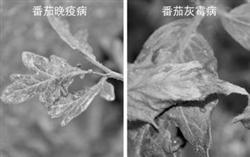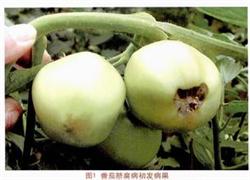How to identify Tomato late Blight and Botrytis cinerea

Late blight and Botrytis cinerea are important diseases that seriously affect the yield and output value of tomato in spring cropping facilities in North China. Early detection and accurate identification is the premise of effective prevention and control. The field symptoms often vary with different varieties and environmental conditions, and they are easy to be confused with each other or with other diseases, which confuses the growers. The symptom characteristics and matters needing attention in the identification of the two diseases are introduced as follows, in order to be helpful to the growers. Symptoms of late blight: the whole growth period and leaves, stems and fruits can be damaged, especially leaves and green fruits. The disease of seedlings generally appeared dark green watery spots from the leaves, and then extended to the stem, showing dark brown rot near the petiole. with the development of the disease, the base of the young stem was waterlogged constricted and the plant wilted and collapsed. At the adult stage, the disease began to develop upward from the lower leaves, from the leaf tip and leaf edge to produce dark green water-stained spots (like water scalding), gradually turned brown, when the disease was serious, the whole plant leaves withered; the disease spots on the stem were brown or dark brown water stains, slightly sunken; fruit spots initially oily dark green, gradually changed to dark brown to brown (yellow) color, disease spots moire, rough hardening. White mildew layer can be produced in all the affected parts when it is moist. Note: (1) sometimes the leaf disease spot is V-shaped from the leaf tip, or when the condition is not suitable, the disease part is dry, and there is no mildew layer, so it is easy to be confused with Botrytis cinerea when simple leaf disease occurs. (2) the disease occurred rapidly when the environmental conditions were particularly suitable, and there was no obvious disease spot in the leaves, but obvious white mildew appeared. (3) simple leaves are easy to be confused with frost injury, but frost injury occurs in the upper leaves. (4) improper fertilization will also lead to the drying up of leaves similar to late blight, which begins from the lower leaves, but is evenly distributed in the whole field. Symptoms of Botrytis cinerea: leaves, stems, flowers and fruits can all be infected, especially fruits, especially green fruits. The disease of the fruit usually starts from the residual petals, receptacles and stigmas on the green fruit, and then spreads to the fruit and stalk, and the pericarp is gray and water-immersed soft rot, the diseased fruit is generally ossified and does not fall off; the leaf infection mostly extends inward in the shape of "V" from the tip or edge of the leaf, and the disease spot is yellow-brown, with deep and shallow wheel pattern or no wheel pattern; the stem infection begins with water-immersed spots, and then develops into oval or irregular shape. A grayish-brown mildew layer is produced on the surface of each site when it is moist. Note: (1) in recent years, we can often see a kind of atypical symptom called ghost face spot, the fruit appears white on the outer edge, green in the middle, and round spot of 3mm in diameter, which occurs more frequently in foreign hard-skinned tomatoes and is easy to be confused with canker and scab. (2) the disease spots of leaves are different, with V-shaped, near-round, irregular shape, with or without wheel patterns. (3) it is easy to produce mildew layer after the disease, but sometimes there is no mildew layer. According to the symptoms and distribution in the field, combined with meteorological and water and fertilizer management and other factors, making a preliminary diagnosis is helpful to emergency control, but because of the diversity and complexity of symptoms, professionals should be asked to conduct indoor microscopic examination to make a diagnosis if necessary, and then modify the prevention and control measures.
- Prev

How to promote tomato fruit setting
In recent years, navel rot has occurred everywhere in tomato production. The manifestation of this disease is in the eggplant fruit expansion period, due to the downward navel of the fruit, the part of the color that can not see the sun turns brown, some dry, some rot, which has a great impact on the yield and quality. We should pay attention to the following points in fertilization: 1. Attach importance to the fertilization of seedbed.
- Next

Field Management Technology of Pepper
Field Management Technology of Pepper
Related
- Where is it suitable to grow horseradish in China? it is expected to see the middle altitude horseradish in Alishan.
- How to prevent tomato virus disease reasonably? (Control methods included)
- Many people like to plant towel gourd on the balcony. What are the main points of this method and management?
- What crops can chili peppers be mixed with?
- Fertilization techniques and matters needing attention in Tomato
- What are the grafting techniques for peach seedlings in spring?
- Harm and control methods of root swelling disease of Chinese cabbage
- What are the pests of sweet potatoes? How to prevent and cure it?
- Symptoms, causes and Control methods of navel Rot in Tomato
- The cause of "Cucumber rotten bibcock" in Farmers' planting Cucumber and its Control Plan

